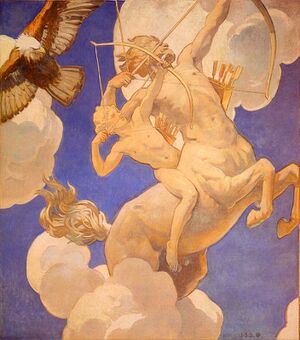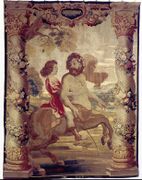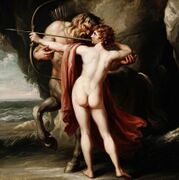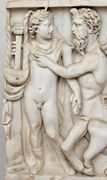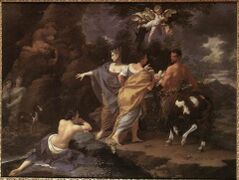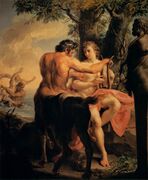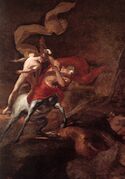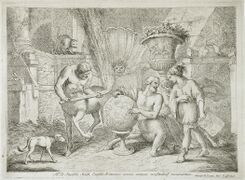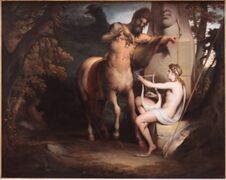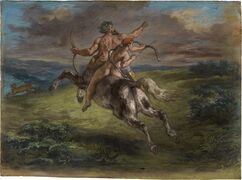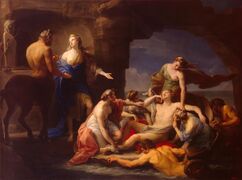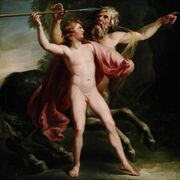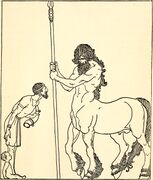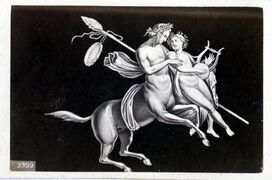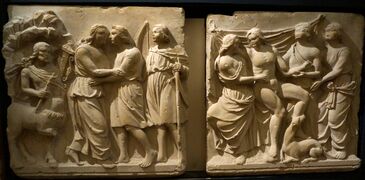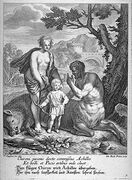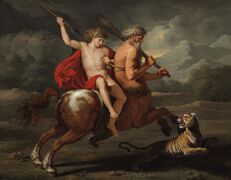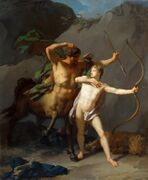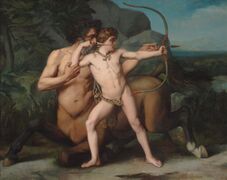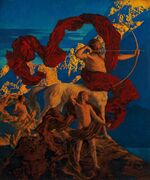خايرون
في الأساطير اليونانية، خايرون (Chiron ؛ /ˈkaɪrən/ KY-rən; also Cheiron or Kheiron; باليونانية قديمة: Χείρων, Kheírōn, hand)[1] was held to be the superlative centaur amongst his brethren since he was called the "wisest and justest of all the centaurs".[2]
السيرة

Chiron was notable throughout Greek mythology for his youth-nurturing nature. His personal skills tend to match those of his foster father Apollo, who taught the young centaur the art of medicine, herbs, music, archery, hunting, gymnastics and prophecy, and made him rise above his beastly nature.[3] Chiron was known for his knowledge and skill with medicine, and thus was credited with the discovery of botany and pharmacy, the science of herbs and medicine.[4]
Like satyrs, centaurs were notorious for being wild, lusty, overly indulgent drinkers and carousers, violent when intoxicated, and generally uncultured delinquents. Chiron, by contrast, was intelligent, civilized and kind, because he was not related directly to the other centaurs[5] due to his parentage. He was the son of the Titan Cronus and the Oceanid Philyra,[6] and thus possible brother to Dolops[7] and Aphrus, the ancestor and eponym of the Aphroi, i.e. the native Africans.[8] Chiron lived predominantly on Mount Pelion; there he married the nymph Chariclo who bore him three daughters, Hippe (also known as Melanippe meaning the "black mare" or Euippe, "good mare"), Endeïs, and Ocyrhoe, and one son Carystus. A different source also stated that his wife was called Nais[بحاجة لمصدر] while a certain Aristaeus was called his son.[9]
Like the other centaurs, Chiron was later expelled by the Lapithae from his home; but sacrifices were offered to him there by the Magnesians until a very late period, and the family of the Cheironidae in that neighbourhood, who were distinguished for their knowledge of medicine, were regarded as his descendants.[10]
المنظر العام
Although a centaur, Chiron's physical appearance often differs somewhat from other centaurs, demonstrating his status and heritage. In traditional Greek representations of Chiron his front legs are human, rather than equine, this is in contrast to the traditional representation of centaurs, which have the entire lower body of a horse.[11] This clearly sets Chiron apart from the other centaurs, making him easily identifiable. This difference may also have highlighted Chiron's unique lineage, being the son of Cronus. Chiron is often depicted carrying a branch with dead hares he has caught hanging from it. Chiron is also often depicted wearing clothes, demonstrating he is more civilised and unlike a normal centaur (the only other occasional exceptions to this rule are the centaurs Nessus and Pholus).
The Education of Achilles wall painting, from the basilica in Herculaneum (top right), is one of the most common Roman depictions of Chiron, as he teaches Achilles the lyre. In this version we see Chiron with a fully equine lower body, in contrast to the ancient Greek representations. In addition to this reconfiguration, Chiron's appearance is further altered with his ears. Whereas previously human, Chiron's ears now match those of a satyr; folded over at the top. This rendering creates a more bestial version of Chiron, much more akin to a standard centaur. It may be possible that due to the rise of written sources, Roman artists were inspired by written descriptions of Chiron; simply using the word centaur, rather than having available traditional visual representations. This may then, not be a deliberate reworking of the Chiron myth on the part of the Romans, but simply a lost nuance of the character in its migration from Greece to Rome. As F. Kelsey writes; "The Chiron of our painting, ... has a body like that of the other centaurs, but the prominence of the human element in his nature is no less marked; he is the wise and gentle teacher, the instructor of an art".[12] Chiron has retained an element of clothing and gained a laurel wreath, suggesting the artist wished to portray nobility, or even divinity, more consistent with the traditional view. It has also been suggested that this fresco is a reproduction of an actual statue in the Roman forum.
الأسطورة
السنوات المبكرة

According to an archaic myth,[13] Chiron was sired by the Titan Cronus when he had taken the form of a horse[14] and impregnated the nymph Philyra.[15]
Chiron's lineage was different from other centaurs, who were born from Ixion, consigned to a fiery wheel, and Nephele ("cloud"), which in the Olympian telling Zeus invented to look like Hera.
Soon after giving birth to Chiron, Philyra abandoned her child out of shame and disgust. Chiron, effectively orphaned, was later found by the god Apollo, who took him under his wing and taught him the art of music, lyre, archery, medicine and prophecy. Apollo's twin sister, Artemis, trained him in archery and hunting. Chiron's uniquely peaceful character, kindness, and intelligence are attributed to Apollo and Artemis.
Some sources speculate that Chiron was originally a Thessalian god, later subsumed into the Greek pantheon as a centaur.[بحاجة لمصدر]
A great healer, astrologer, and respected oracle, Chiron was said to be the first among centaurs and highly revered as a teacher and tutor. Among his pupils were many culture heroes: Asclepius, Aristaeus, Ajax, Aeneas, Actaeon, Caeneus, Theseus, Achilles, Jason, Peleus, Telamon, Perseus, sometimes Heracles, Oileus, and in one Byzantine tradition, even Dionysus.
According to Ptolemaeus Chennus of Alexandria "Dionysus was loved by Chiron, from whom he learned chants and dances, the bacchic rites and initiations."[16]
There is also a persistent link with Peleus throughout Chiron's myth. This can be explained that the latter was the grandfather of Peleus through his daughter Endeis who married the king of Aegina, Aeacus. Chiron saved the life of Peleus when Acastus tried to kill him by taking his sword and leaving him out in the woods to be slaughtered by the centaurs. Chiron retrieved the sword for Peleus. Chiron then explained to Peleus how to capture the nymph Thetis, leading to their marriage.
Chiron is also connected with the story of the Argonauts, whom he received kindly when they came to his residence on their voyage, for many of the heroes were his friends and pupils.[17]
وفاته
His nobility is further reflected in the story of his death, as Prometheus sacrificed his life, allowing mankind to obtain the use of fire. As the son of Cronus he was immortal, so it was left to Heracles to arrange a bargain with Zeus to exchange Chiron's immortality for the life of Prometheus, who had been chained to a rock and left to die for his transgressions.[18] Chiron was pierced with an arrow belonging to Heracles that had been treated with the blood of the Hydra, or, in other versions, poison that Chiron had given to the hero when he had been under the honorable centaur's tutelage. According to a Scholium on Theocritus,[19] this had taken place during the visit of Heracles to the cave of Pholus on Mount Pelion in Thessaly during his fourth labour, defeating the Erymanthian Boar. While they were at supper, Heracles asked for some wine to accompany his meal. Pholus, who ate his food raw, was taken aback. He had been given a vessel of sacred wine by Dionysus sometime earlier, to be kept in trust by the centaurs until the right time for its opening. At Heracles' prompting, Pholus was forced to produce the vessel of sacred wine. The hero, gasping for wine, grabbed it from him and forced it open. Thereupon the vapors of the sacred wine wafted out of the cave and intoxicated the wild centaurs led by Nessus who had gathered outside. They attacked with stones and fir trees the cave which was located in the neighbourhood of Malea. Heracles was forced to shoot many arrows (poisoned with the blood of the Hydra) to drive them back. During the assault, Chiron was hit in the thigh by one of the poisoned arrows. After the centaurs had fled, Pholus emerged from the cave to observe the destruction. Being of a philosophical frame of mind, he pulled one of the arrows from the body of a dead centaur and wondered how such a little thing as an arrow could have caused so much death and destruction. In that instant, he let slip the arrow from his hand and it dropped and hit him in the hoof, killing him instantly. This, however, is open to controversy, because Pholus shared the "civilized centaur" form with Chiron in some art images, and thus would have been immortal.
Ironically, Chiron, the master of the healing arts, could not heal himself and willingly gave up his immortality. For this reason, his half-brother Zeus took pity on him and thus placed him among the stars in the sky to be honored. The Greeks identified him as the constellation Centaurus.[20]
In Ovid's poem Fasti, Ovid has the hero Hercules visiting Chiron's home on Pelion while the child Achilles is there.[21] While Chiron is examining Hercules' weapons, one of the arrows dipped in Lernaean hydra venom falls on Chiron's left foot and poisons him:
- And while the old man fingered the shafts clotted with poison, one of the arrows fell out of the quiver and stuck in his left foot. Chiron groaned and drew the steel from his body.[22]
Chiron then tries to use herbs to heal himself, but fails. After nine days with a weeping Achilles looking on, Chiron passes into the stars becoming a constellation.[23]
تلاميذه

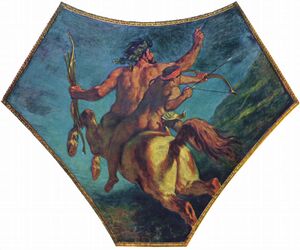
Throughout Greek mythology, there were many heroes who were trained by Chiron. Among the students of Chiron are:
- Achilles – The son of Peleus. When Achilles' mother Thetis left home and returned to the Nereids, Peleus brought his son Achilles to Chiron, who received him as a disciple, and fed him on the innards of lions and wild swine, and the marrow of she-wolves.
- Actaeon – Actaeon, who was bred by Chiron to be a hunter, is famous for his terrible death. He was devoured by his own dogs after being turned into a deer for accidentally stumbling upon Artemis bathing. The dogs, ignorant of what they had done, came to the cave of Chiron seeking their master, and the Centaur fashioned an image of Actaeon in order to soothe their grief.
- Aeneas – a Dardanian prince and son of Aphrodite by Anchises.
- Ajax – A Greek hero who fought in the Trojan War. He is the son of Telamon and the half-brother of Teucer.
- Aristaeus – The Muses were, according to some, those who taught Aristaeus the arts of healing and of prophecy. Aristaeus discovered honey and the olive. After the death of his son Actaeon, he migrated to Sardinia.
- Asclepius – The great healing power of Asclepius is based on Chiron's teaching. Artemis killed Asclepius' mother Coronis on Apollo's orders while still pregnant after she had an affair, he snatched the child from the pyre and brought him to Chiron, who reared him and taught him the arts of healing and hunting.
- Caeneus – A Lapith who fought in the Centauromachy.
- Castor and Pollux – twin Spartan sons of Leda by Tyndareus and Zeus
- Diomedes – King of Argos and one of the Achaean leaders.
- Dionysus – god of wine and son of Zeus by the mortal Semele
- Heracles – The son of Zeus. Some versions of Greek mythology state that Heracles was trained by Chiron.
- Jason – In an early tradition,[24] Aeson gave his son Jason to the Centaur Chiron[25] to rear at the time when he was deposed by King Pelias. Jason is the captain of the Argonauts.
- Machaon – son of Asclepius and a physician during the Trojan War.
- Medus – Medus, who some call Polyxenus and others Medeus, is the namesake of the country Media. He was the son of Medea by Jason.[26] Medus died in a military campaign against the Indians. Other versions of the story say he was the son of Aegeus, King of Athens.
- Meleager – an Argonaut and leader of the Calydonian hunters.
- Mnestheus
- Nestor – King of Pylos and an Argonaut and also one of the Achaean Leaders.
- Odysseus – King of Cephallenia and one of the Achaean Leaders.
- Oileus – A member of the Argonauts.
- Palamedes – prince of Euboea and one of the Achaean leaders.
- Podalirius – son of Asclepius and a physician during the Trojan War.
- Patroclus – Patroclus' father, Menoetius, left him in Chiron's cave to study (side by side with Achilles) the chords of the harp, learn to hurl spears and mount and ride upon the back of Chiron.
- Peleus – Peleus, father of Achilles, was once rescued by Chiron: Acastus, son of Pelias, purified Peleus for having killed (undesignedly) his father-in-law Eurytion. However, Acastus' wife, Astydameia, fell in love with Peleus, and when he refused her she told Acastus that Peleus had attempted to rape her. Acastus would not kill the man he had purified, but took him to hunt on Mount Pelion. When Peleus had fallen asleep, Acastus deserted him, hiding his sword. On arising and looking for his sword, Peleus was caught by the centaurs and would have perished, if he had not been saved by Chiron, who also returned him his sword after having sought and found it. Chiron arranged the marriage of Peleus with Thetis,[27] bringing Achilles up for her. He also told Peleus how to conquer the Nereid Thetis who, changing her form, could prevent him from catching her. In other legends, it was Proteus who helped Peleus. When Peleus married Thetis, he received from Chiron an ashen spear, which Achilles took to the war at Troy.[28] This heavy lance is the same with which Achilles healed Telephus by scraping off the rust.
- Perseus – The son of Zeus. A Greek hero who was known for beheading Medusa.
- Protesilaus – son of Iphiclus, who led the Phylacean fleet during the Trojan war
- Telamon – A Greek king who is the father of Ajax and Teucer.
- Theseus – The son of either Poseidon or King Aegeus of Athens. Known for slaying the Minotaur.
تعاليم خايرون
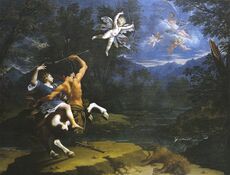
A didactic poem, Precepts of Chiron, has been lost. However, fragments in heroic hexameters that survive in quotations are considered to belong to it.[29] The common thread in the fragments, which may reflect in some degree the Acharnian image of Chiron and his teaching, is that it is expository rather than narrative, and suggests that, rather than recounting the inspiring events of archaic times as men like Nestor[30] or Glaucus[31] might do, Chiron taught the primeval ways of mankind, the gods and nature, beginning with the caution "First, whenever you come to your house, offer good sacrifices to the eternal gods".
Statius' Achilleid
The Achilleid was to be an epic poem on the life of Achilles. However, its author, Statius, died during the writing of the second book late in the first century AD during the reign of the Emperor Domitian. The Achilleid shows the relationship between Chiron and his charge, Achilles. During Book One, the close relationship between Chiron and Achilles is made clear when Thetis spends the evening with them in Chiron's cave on Mount Pelion, before leaving with Achilles. Chiron is shown in a paternal capacity, rather than that of merely a teacher, and is depicted as far from animal.
Night draws to slumber. The huge Centaur collapses on stone and Achilles fondly twines himself about his shoulders, though his mother is there, preferring the familiar bosom. (1.195–97).
Here, Statius is showing a loving relationship between the two characters, which the traditional view of Chiron never explored. Later, when describing what he ate when growing up, Achilles refers to Chiron as a parent; "thus that father of mine used to feed me" (2.102), the Latin used here is 'pater' so we may judge this an accurate translation. This further demonstrates the nature of the loving relationship between Chiron and Achilles. Statius here may be continuing a theme started by Ovid in Fasti several years earlier.
In Fasti, on Chiron's death, Achilles says "'Live, I beg you; don't leave me, dear father [pater]!'"(5.412), this would suggest that in Rome the reconfiguration of Chiron's myth was as a loving and loved foster parent, rather than simply teacher. Chiron's relationship with his pupil is used to demonstrate a Roman longing for the father-son relationship.
In addition to Chiron's loving characteristics developed in Book One, Book Two of The Achilleid has Achilles describe many tasks Chiron would make him perform during his heroic education, including standing in fast flowing rivers;
I stood, but the angry river and the mist of his broad rush took me back. He bore down on me with savage threats and scolded to shame me. I did not leave till ordered (2.146–150).
There is a clear contrast here in the hardship and insults Chiron is directing at his pupil compared to his previous kindness. However, this duality can be seen as a demonstration of a traditional Roman education, especially a noble one; learning both military and refined arts. Centaurs in antiquity were often remembered for their battle with the Lapiths. Statius deliberately disassociates Chiron from this story with his description of Chiron's cave on Pelion,
Here are no darts that have tasted human blood, no ash trees fractured in festive combats, nor mixing bowls shattered upon kindred foes (1.111–15).
Instead of combat, the emphasis is that Chiron's weapons are only used for hunting and there are no signs of savage behaviour. In addition to Achilles' descriptions of the physical lessons Chiron gives him he also refers to a more cultured education,
He fixed in my mind the precepts of sacred justice (2.163–4).
Statius creates an image of Chiron that is not only a loving father, but a strict and wise teacher, disassociated with the bestial aspects of centaurs.
معرض
انظر أيضاً
- Chyron, a synonym for lower third television graphics
- Chyron Corporation, named in reference to Chiron
- 2060 Chiron, a small Solar System body named after Chiron
الهامش
- ^ Compare the Dactyls, "fingers", ancient masters of the art of metallurgy and magical healers.
- ^ Homer, Iliad 11.831
- ^ Xenophon, Cynegeticus 1; Philostratus the Athenian, Heroicus 9, Icon. 2.2; Pindar, Pythian Odes 9.65
- ^ Pliny the Elder, Naturalis Historia 7.56.3
- ^ Homer, Iliad 11.831
- ^ Scholia on Apollonius Rhodius, Argonautica 2.1235 citing Pherecydes; Pliny the Elder, Naturalis Historia 7.56.3; Hyginus, De Astronomica 2.38.1 ff.
- ^ Hyginus, Fabulae Preface
- ^ Suida, Suda Encyclopedia s.v. Aphroi
- ^ Greek Lyric IV: Bacchylides, fr. 45 (from Scholiast on Apollonius of Rhodes)
- ^ Plutarch, Symposiacs 3.1; Müller, Orchom. p. 249
- ^ Hornblower & Spawforth (2004). The Oxford Companion to Classical Civilization. Oxford: Oxford University Press.
- ^ Kelsey, W. (January–March 1908). "Codrus's Chiron and a Painting from Herculaneum". American Journal of Archaeology. 12 (1): 30–38. doi:10.2307/496854. JSTOR 496854.
- ^ A quote from the lost Titanomachia, provided as a scholium on Apollonius Rhodius' Argonautica 1.554 (on-line quote); Apollodorus, 1.8-9, may have drawn upon the same source.
- ^ Compare the stallion-Poseidon who sired the steed Arion upon Demeter.
- ^ Apollodorus, 1.2.4
- ^ "Ὡς Διόνυσος ἐρώμενος Χείρωνος, ἐξ οὗ καὶ μάθοι τούς τε κώμους καὶ τὰς βακχείας καὶ τὰς τελετάς." (Ptolemaeus Chennus, New History, quoted in Photios of Constantinople, Library 190
- ^ Apollonius of Rhodes, Argonautica 1.554; Orphic Argonautica 375 ff.
- ^ Apollodorus, 2.5.4
- ^ Theocritus, Idylls 7.149
- ^ Hyginus, De Astronomica 2.38.1 ff
- ^ Ovid, Fasti 5.391–396
- ^ Ovid, Fasti 5.397–398
- ^ Ovid, Fasti 5.400–414
- ^ Fragment 40 (fr. 13 in the Loeb) of the Hesiodic Catalogue of Women (Theoi.com| on-line text in translation).
- ^ Pindar, Nemean Ode 3.54
- ^ Hesiod, Theogony 993: "And she was subject to Iason, shepherd of the people, and bare a son Medeus whom Cheiron the son of Philyra brought up in the mountains."
- ^ Pindar, Isthmian Ode 8.41
- ^ Homer, Iliad 16.143 & 19.390
- ^ Hesiod II (1936). The Homeric Hymns and Homerica. Translated by H. G. Evelyn-White (2nd ed.). Loeb Classical Library 503. pp. 73–.
- ^ In both Iliad and Odyssey.
- ^ Homer, Iliad 6.155–203
المراجع
- Apollodorus, The Library with an English Translation by Sir James George Frazer, F.B.A., F.R.S. in 2 Volumes, Cambridge, MA, Harvard University Press; London, William Heinemann Ltd. 1921. ISBN 0-674-99135-4. Online version at the Perseus Digital Library. Greek text available from the same website.
- Apollonius Rhodius, Argonautica translated by Robert Cooper Seaton (1853-1915), R. C. Loeb Classical Library Volume 001. London, William Heinemann Ltd, 1912. Online version at the Topos Text Project.
- Apollonius Rhodius, Argonautica. George W. Mooney. London. Longmans, Green. 1912. Greek text available at the Perseus Digital Library.
- Gaius Julius Hyginus, Astronomica from The Myths of Hyginus translated and edited by Mary Grant. University of Kansas Publications in Humanistic Studies. Online version at the Topos Text Project.
- Gaius Julius Hyginus, Fabulae from The Myths of Hyginus translated and edited by Mary Grant. University of Kansas Publications in Humanistic Studies. Online version at the Topos Text Project.
- Hesiod, Theogony from The Homeric Hymns and Homerica with an English Translation by Hugh G. Evelyn-White, Cambridge, MA.,Harvard University Press; London, William Heinemann Ltd. 1914. Online version at the Perseus Digital Library. Greek text available from the same website.
- Homer, The Iliad with an English Translation by A.T. Murray, Ph.D. in two volumes. Cambridge, MA., Harvard University Press; London, William Heinemann, Ltd. 1924. ISBN 978-0674995796. Online version at the Perseus Digital Library.
- Homer, Homeri Opera in five volumes. Oxford, Oxford University Press. 1920. ISBN 978-0198145318. Greek text available at the Perseus Digital Library.
- Lucius Flavius Philostratus, Heroica, translation by Jennifer K. Berenson Maclean and Ellen Bradshaw Aitken, Flavius Philostratus: On Heroes, WGRW 3 (Atlanta: Society of Biblical Literature, 2002), XX. Harvard University's Center for Hellenic Studies. Online version at the Topos Text Project.
- Lucius Flavius Philostratus, Flavii Philostrati Opera. Vol 2. Carl Ludwig Kayser. in aedibus B. G. Teubneri. Lipsiae. 1871. Greek text available at the Perseus Digital Library.
- The Orphic Argonautica, translated by Jason Colavito. Copyright 2011. Online version at the Topos Text Project.
- Pausanias, Description of Greece with an English Translation by W.H.S. Jones, Litt.D., and H.A. Ormerod, M.A., in 4 Volumes. Cambridge, MA, Harvard University Press; London, William Heinemann Ltd. 1918. ISBN 0-674-99328-4. Online version at the Perseus Digital Library
- Pausanias, Graeciae Descriptio. 3 vols. Leipzig, Teubner. 1903. Greek text available at the Perseus Digital Library.
- Pindar, Odes translated by Diane Arnson Svarlien. 1990. Online version at the Perseus Digital Library.
- Pindar, The Odes of Pindar including the Principal Fragments with an Introduction and an English Translation by Sir John Sandys, Litt.D., FBA. Cambridge, MA., Harvard University Press; London, William Heinemann Ltd. 1937. Greek text available at the Perseus Digital Library.
- Pliny the Elder, The Natural History. John Bostock, M.D., F.R.S. H.T. Riley, Esq., B.A. London. Taylor and Francis, Red Lion Court, Fleet Street. 1855. Online version at the Perseus Digital Library.
- Pliny the Elder, Naturalis Historia. Karl Friedrich Theodor Mayhoff. Lipsiae. Teubner. 1906. Latin text available at the Perseus Digital Library.
- Publius Ovidius Naso, Fasti translated by James G. Frazer. Online version at the Topos Text Project.
- Publius Ovidius Naso, Fasti. Sir James George Frazer. London; Cambridge, MA. William Heinemann Ltd.; Harvard University Press. 1933. Latin text available at the Perseus Digital Library.
- Suida, Suda Encyclopedia translated by Ross Scaife, David Whitehead, William Hutton, Catharine Roth, Jennifer Benedict, Gregory Hays, Malcolm Heath Sean M. Redmond, Nicholas Fincher, Patrick Rourke, Elizabeth Vandiver, Raphael Finkel, Frederick Williams, Carl Widstrand, Robert Dyer, Joseph L. Rife, Oliver Phillips and many others. Online version at the Topos Text Project.
- Theocritus, Idylls from The Greek Bucolic Poets translated by Edmonds, J M. Loeb Classical Library Volume 28. Cambridge, MA. Harvard Univserity Press. 1912. Online version at theoi.com
- Theocritus, Idylls edited by R. J. Cholmeley, M.A. London. George Bell & Sons. 1901. Greek text available at the Perseus Digital Library.
- William Smith. A Dictionary of Greek and Roman biography and mythology. s.v. Cheiron. London (1848)
وصلات خارجية
 Media related to خايرون at Wikimedia Commons
Media related to خايرون at Wikimedia Commons
- Short description is different from Wikidata
- Articles containing Ancient Greek (to 1453)-language text
- Articles with unsourced statements from May 2017
- Articles with unsourced statements from July 2012
- قناطير
- هجائن أسطورية
- معلمون يونانيون أسطوريون للآلهة
- شخصيات التحولات
- شخصيات في الأرگونوتيكا
- شخصيات في الأساطير اليونانية
- أساطير تسالية
- أسكلپيوس في الأساطير
- أساطير هرقل
- أعمال زيوس


